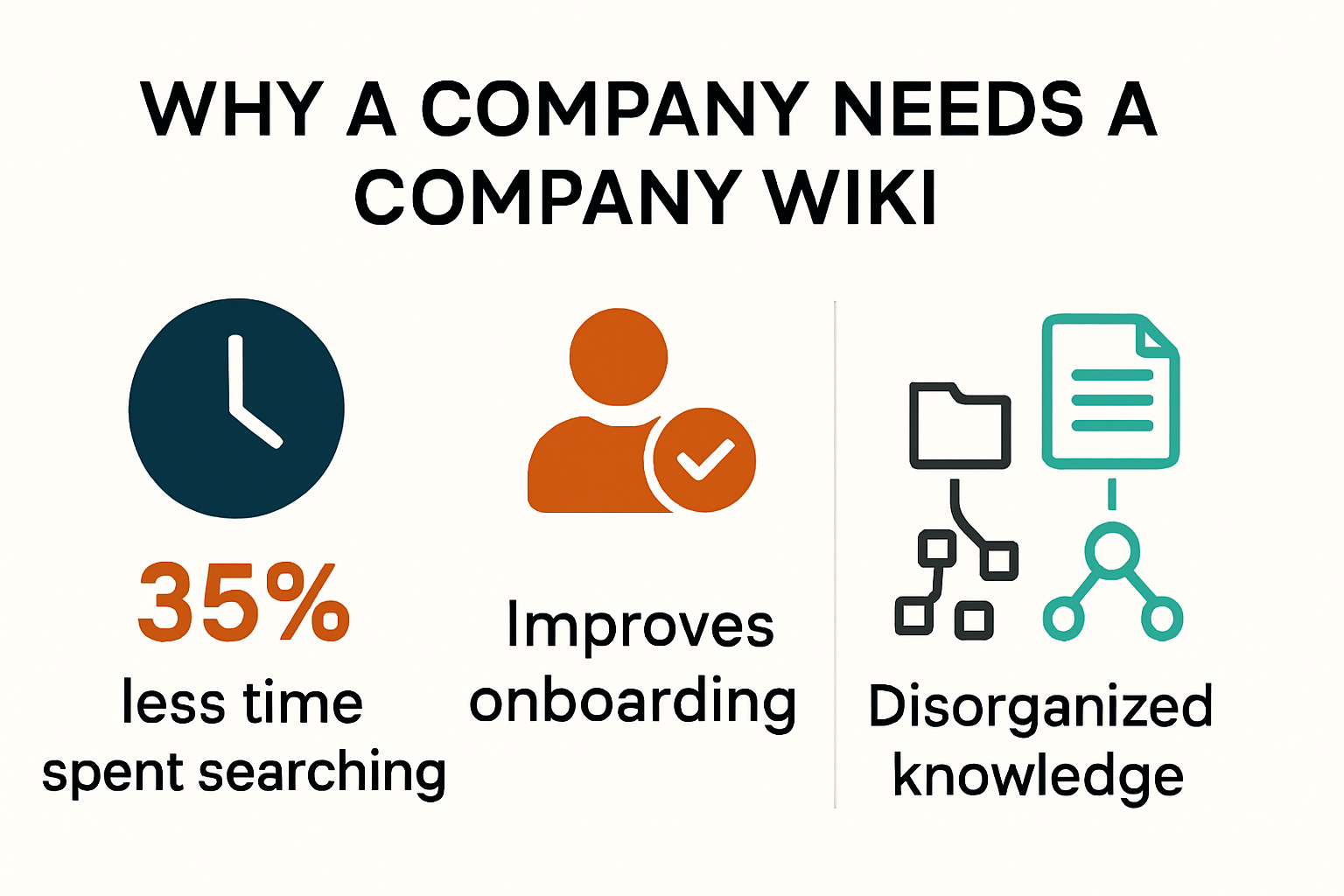Building a company wiki feels like a massive project, especially when teams already juggle overflowing inboxes and scattered documents. Here is something few realize. The average employee spends nearly 20% of their workweek just searching for internal information according to leading studies. So creating a company wiki is not just about storing policies or guides, it is about reclaiming hundreds of hours every year and unlocking real teamwork.
Table of Contents
- Why Your Business Needs A Company Wiki
- Choosing The Right Wiki Platform For Teams
- Essential Steps For Setting Up Company Wiki
- Best Practices To Keep Your Wiki Effective
Quick Summary
| Takeaway | Explanation |
|---|---|
| Centralize Knowledge for Efficiency | A company wiki centralizes institutional knowledge, making information more accessible and reducing time wasted in searches. |
| Select the Right Wiki Platform | Evaluate platforms based on usability, integration, and scalability to enhance collaboration and knowledge sharing. |
| Establish Governance Roles | Define specific roles for content contributors, reviewers, and administrators to ensure quality and consistency in the wiki. |
| Promote Continuous Improvement | Regularly update content, gather feedback, and encourage team engagement to keep the wiki relevant and effective. |
| Invest in User Training | Comprehensive training improves user adoption and cultivates a culture of knowledge sharing among team members. |
Why Your Business Needs a Company Wiki
Company wikis have transformed how organizations manage and share critical information. In an era of rapid digital collaboration, a centralized knowledge repository is no longer a luxury but a strategic necessity for businesses seeking competitive advantage.
The Knowledge Management Revolution
Modern businesses face unprecedented challenges in information management. According to research from the Aslib Journal of Information Management, successful corporate wikis depend on three critical factors: top management support, technical infrastructure, and employees’ knowledge-sharing capabilities. These systems are not just digital archives but dynamic platforms that enable real-time collaboration and institutional memory preservation.
The traditional method of storing information in disconnected email threads, scattered documents, and individual hard drives creates significant organizational inefficiency. A company wiki centralizes institutional knowledge, making critical information accessible, searchable, and updatable by authorized team members. This approach dramatically reduces time spent searching for information and minimizes knowledge loss when employees leave the organization.

Driving Organizational Efficiency
The International Symposium on Wikis and Open Collaboration highlights that corporate wiki systems can substantially improve work processes and collaboration efficiency. By creating a single source of truth, businesses can:
- Reduce Onboarding Time: New employees can quickly understand company processes, protocols, and historical context.
- Enhance Cross-Department Communication: Break down information silos and promote transparent knowledge sharing.
- Preserve Institutional Knowledge: Capture expertise from long-term employees and make it permanently accessible.
Strategic Knowledge Infrastructure
A well-implemented company wiki is more than a documentation tool. It represents a strategic investment in organizational intelligence. By creating a living, breathing knowledge ecosystem, businesses can accelerate learning, promote innovation, and create a culture of continuous improvement.
The most successful wikis are those that are actively maintained, regularly updated, and integrated into daily workflow. This means establishing clear guidelines for content creation, designating knowledge champions, and making wiki usage a core part of organizational communication strategy.
For leaders contemplating setting up a company wiki, the decision is clear: in a knowledge-driven economy, information accessibility and collaborative knowledge management are not optional. They are fundamental to maintaining organizational agility, reducing redundancy, and empowering teams to work smarter, not harder.
Choosing the Right Wiki Platform for Teams
Selecting the ideal wiki platform represents a critical decision for organizations aiming to optimize knowledge management and team collaboration. The right platform can transform how teams communicate, share information, and maintain institutional memory.
Key Selection Criteria
According to CIO’s comprehensive guide, organizations must carefully evaluate multiple factors when selecting a wiki platform. The software delivery model represents the first crucial consideration. Teams can choose between on-premise solutions, cloud-hosted platforms, or hybrid appliance models depending on their specific security requirements and infrastructure constraints.
Authentication integration emerges as another critical aspect. The wiki platform must seamlessly connect with existing organizational authentication systems, ensuring secure and controlled access. Version control capabilities are equally important, allowing teams to track content changes, restore previous versions, and maintain a comprehensive audit trail of collaborative efforts.
User Experience and Adoption
Microsoft’s business insights highlight eight practical tips for selecting a wiki platform that guarantees high user engagement. The most successful platforms offer intuitive navigation, powerful search functionality, and smooth integration with existing collaboration tools.
Key features to prioritize include:
- Intuitive Interface: Minimal learning curve for team members
- Robust Search Capabilities: Quick information retrieval
- Seamless Integration: Compatibility with current communication tools
- Customization Options: Ability to adapt to specific organizational needs
To help readers quickly compare the main types of wiki platforms mentioned, the following table summarizes their primary characteristics and key considerations.
| Platform Type | Deployment Model | Key Considerations |
|---|---|---|
| On-premise | Installed locally | High security, internal maintenance |
| Cloud-hosted | Hosted in cloud | Easier updates, less IT overhead |
| Hybrid Appliance | Combination of both | Flexibility, complex setup |
Technical Considerations and Flexibility
Open-source solutions like Tiki Wiki CMS Groupware demonstrate the diverse ecosystem of wiki platforms available to organizations. These platforms often provide extensive features such as fine-grained access control, built-in databases, and comprehensive revision tracking.
When evaluating potential wiki platforms, leaders should conduct thorough assessments that go beyond surface-level features. Consider factors like scalability, security protocols, mobile accessibility, and long-term support. A platform that works perfectly for 20 team members might become unwieldy at 200 or 2000.
The ultimate goal is not just selecting a wiki platform but creating a dynamic knowledge ecosystem that evolves with your organization. Successful implementation requires ongoing commitment, regular training, and a culture that values transparent, collaborative knowledge sharing.
Essential Steps for Setting Up Company Wiki
Implementing a successful company wiki requires strategic planning, careful execution, and ongoing management. The process involves more than simply selecting a platform it demands a comprehensive approach to knowledge sharing and organizational collaboration.
Planning and Preparation
According to Microsoft’s comprehensive guidelines, the first critical step is deciding on content based on your specific audience and organizational needs. This means conducting a thorough assessment of the information your teams require, identifying knowledge gaps, and determining the primary objectives of your wiki.
Begin by mapping out the initial content structure. What departments and knowledge domains will your wiki cover? Typical areas might include company policies, standard operating procedures, project documentation, technical guides, and training materials. Develop a clear content taxonomy that makes information intuitive and easily discoverable.
Establishing Governance and Roles
Business News Daily emphasizes the importance of establishing clear community guidelines. This involves defining explicit roles and implementing robust access controls. Not everyone in the organization should have unrestricted editing capabilities. Instead, create a tiered permission system:
- Content Contributors: Employees authorized to create and edit specific sections
- Reviewers: Team members who validate and approve content accuracy
- Administrators: Individuals with full platform management capabilities
Define clear guidelines for content creation, including formatting standards, citation requirements, and update protocols. These rules ensure consistency and maintain the wiki’s overall quality and reliability.

To clarify team responsibilities, the table below summarizes the main governance roles in a company wiki and their primary functions.
| Role | Main Responsibilities |
|---|---|
| Content Contributor | Create and edit content in designated areas |
| Reviewer | Validate, approve, and ensure accuracy of content |
| Administrator | Manage platform settings and permissions |
Launch and Continuous Improvement
CIO recommends a phased approach to wiki implementation, starting with a pilot group to gather initial feedback and refine the platform. Begin by populating the wiki with foundational content, then gradually expand its scope. Promote the wiki through executive communication channels, demonstrating leadership’s commitment to knowledge sharing.
Encourage active participation by making wiki contributions a recognized part of performance evaluations. Recognize and reward team members who consistently contribute high-quality, valuable content. Schedule regular review sessions to assess the wiki’s effectiveness, identify improvement areas, and adapt to changing organizational needs.
Successful company wikis are not static repositories but dynamic, living systems that evolve with the organization. They require continuous nurturing, active management, and a culture that values transparent, collaborative knowledge sharing. By following these essential steps, leaders can transform their wiki from a simple documentation tool into a powerful strategic asset that drives organizational learning and innovation.
Best Practices to Keep Your Wiki Effective
Maintaining an effective company wiki requires ongoing commitment, strategic management, and a proactive approach to knowledge sharing. Unlike static documentation systems, a successful wiki is a dynamic, living platform that continually evolves with organizational needs.
Content Management and Quality Control
Research from the National Center for Biotechnology Information highlights that organizational wikis succeed through rigorous content management policies and transparent update mechanisms. Establishing clear guidelines for content creation, review, and maintenance is fundamental to maintaining the wiki’s reliability and usefulness.
Implement a robust review process that includes:
- Regular Content Audits: Scheduled comprehensive reviews to verify accuracy and relevance
- Version Tracking: Detailed logs of all content modifications
- Expiration Notifications: Automatic alerts for outdated or potentially obsolete information
Encourage a culture of continuous improvement where team members view wiki maintenance as a collective responsibility. This means creating channels for feedback, suggesting updates, and recognizing contributors who consistently enhance the platform’s quality.
User Engagement and Training
A wiki’s effectiveness directly correlates with user adoption and engagement. Organizations must invest in comprehensive training programs that not only teach technical platform usage but also cultivate a knowledge-sharing mindset. Develop onboarding modules that introduce new team members to the wiki’s purpose, navigation, and contribution expectations.
Consider implementing:
- Periodic Training Sessions: Workshops on advanced wiki usage and content creation
- User Support Channels: Dedicated resources for resolving wiki-related queries
- Contribution Recognition: Formal acknowledgment of meaningful wiki contributions
Technological and Strategic Maintenance
Technical maintenance is as crucial as content management. Regularly assess the wiki platform’s performance, security features, and alignment with organizational growth. This involves monitoring user analytics, addressing potential technical limitations, and staying updated with emerging collaboration technologies.
Key strategic maintenance aspects include:
- Performance Monitoring: Track user engagement metrics and platform responsiveness
- Security Updates: Implement robust access controls and regular security assessments
- Integration Capabilities: Ensure seamless connection with other organizational tools
Effective wikis transcend mere documentation. They represent a strategic knowledge management approach that transforms information sharing from a passive activity to an active, collaborative process. By prioritizing content quality, user engagement, and continuous improvement, organizations can create a wiki that becomes an indispensable strategic asset.
Remember that a successful wiki is never truly finished. It is a perpetual work in progress, reflecting the dynamic nature of organizational knowledge and the collaborative spirit of your team.
Frequently Asked Questions
What is a company wiki and why do I need one?
A company wiki is a centralized knowledge repository that helps organizations manage and share critical information efficiently. It reduces time spent searching for information and enhances collaboration among teams.
How do I choose the right wiki platform for my organization?
Select a wiki platform by evaluating usability, integration capabilities, security features, and scalability based on your team’s specific needs and workflow requirements.
What are the key steps to set up a company wiki?
Essential steps include planning content structure, establishing governance roles, launching the wiki with foundational content, and promoting continuous improvement through regular updates and feedback collection.
How can I keep my company wiki effective in the long run?
Maintain your wiki’s effectiveness by implementing rigorous content management policies, providing user training, encouraging active participation, and conducting regular assessments of content relevance and user engagement.
Build an Effortless Company Wiki and Reclaim Your Team’s Time
If you are tired of watching your team lose hours searching for scattered documents and uncertain about how to centralize company knowledge, you are not alone. This 2025 Guide for Leaders pointed out the huge productivity gap caused by disconnected internal information. The core pain is clear: without a structured company wiki, onboarding slows down, knowledge is lost, and efficiency suffers. Every day that your business operates without a unified, well-managed knowledge base is another day of lost efficiency and missed opportunities for collaboration.

Imagine combining your brand-new company wiki with all your project management, CRM, automation, and team collaboration needs in one place. Gammatica.com gives you an intuitive platform where you can launch a secure, organized wiki with permission controls, connect it directly to task workflows, and harness AI-powered templates to start fast. Join business leaders who have reduced administrative headaches and freed up to 16 extra hours each week by integrating documentation and management through a single solution. Explore Gammatica’s company wiki and productivity tools now and see how quickly your team can work smarter instead of harder.



